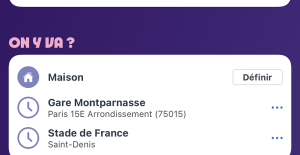It takes a while, but then it becomes more and more noticeable. The metaverse of the Facebook group Meta is now a two-class society. Everyone was once the same here, in this draft of a three-dimensional world in which people move with their digital images in the form of avatars. In our test of the latest virtual reality glasses Quest Pro, it turns out that we are different than - almost - everyone else.
Why? Our avatar can smile. And he can raise his eyebrows. And he can see left and right with his eyes without moving his head. In short: Our avatar can perform some of the most natural movements that the user of the glasses exercises with great ease, but which have not yet been transferred to Meta's virtual world.
At first glance, that sounds like a small step for mankind – and it is. Still, the Quest Pro is a step forward. Above all, it shows the path Meta wants to take to make his vision of the Metaverse a little more real. The new glasses eliminate some of the shortcomings that previously stood in the way. Eye and face tracking is one of them.
Technically, this is now solved, thanks to sensors that are aligned inwards. But whether users really want that is another question that Meta itself does not want to answer conclusively. Because the facial expressions also express the feelings of the user, which certainly belong to the more sensitive data.
This is probably also the reason why this tracking has been switched off for the time being and has to be activated by the user. According to Meta, the facial expressions are only processed on the glasses and are not stored or transmitted to Meta and other companies.
The fact that in the two-week test, on our journey through the metaverse, we only met a few avatars who are able to smile spontaneously is partly due to the fact that hardly anyone is currently using the Quest Pro. On the other hand, many developers have not yet built this function into their applications. This is likely to happen more often in the future.
We can check how well the tracking works when setting up our own avatar, where we look in a mirror. Amaze, the right lip sync and squint work great. Sticking out the tongue, on the other hand, is ignored. It's not entirely clear to us whether Meta is forcing us to be polite or censoring us for technical reasons.
So far we had entered the Metaverse with Quest 2. When it comes to the Quest Pro, we are surprised to find that it has become even heavier at 722 grams. But while the Quest 2, which is still to be sold, has all the weight on the face, the Quest Pro distributes it better because the battery is now at the back of the head. It's just better balanced. And yet wearing it becomes uncomfortable after a good hour because it presses on the forehead.
Nevertheless, the Quest Pro is a lot more fun than the Quest 2. In addition to the eye and face tracking, which the others tend to have, there are many reasons for this, above all the better optics. Although the two screens in front of the eyes do not have a higher resolution than on the Quest 2, the image is clearer, sharper and has better black levels.
This is probably also due to the pancake lenses, which are thinner on the one hand and distort the image less on the other. In addition, people who wear glasses can comfortably carry their glasses under the Quest Pro. A separate dial increases the distance between the face and the lenses.
Meta sees the Quest Pro more as a tool for professional users who, for example, design objects together in the Metaverse or work on virtual screens. This works quite well in the "Horizon Workrooms" application, where you can meet for a meeting, but you can also work on your computer.
We find this implemented even better in the "Immersed" app, where we can connect to our notebook and position three huge virtual displays in the room. We can think of many situations where this makes a lot of sense. When traveling by train or plane, for example. Or even in the home office, when the kitchen table becomes a perfectly equipped office workplace.
But our greatest hope is dashed by the Quest Pro. Although writing on the virtual displays can be read a little better than with the Quest 2, it is by no means sharp enough to work seriously with virtual screens for longer periods of time. Despite the better optics, we still clearly see a fly screen effect, i.e. individual pixels.
The display does not yet live up to this claim. Apart from that, mouse movements are transferred to the metaverse with a noticeable delay. At the same time, the Quest Pro shows what would be possible and what is not yet feasible.
The same goes for another feature that Meta calls passthrough. This turns virtual reality into mixed reality, or mixed reality. This was already possible with Quest 2 by tapping the glasses twice in a row.
The recording of the surroundings was then transferred to the displays via the external camera, so that you could see a table that was in the way, for example. But all of this was just a two-dimensional black and white image. The Quest Pro masters color see-through because it combines the image from three cameras located on the outside of the goggles.
This also enables a stereoscopic view, which provides the view with depth information and thus makes it much more realistic. In addition, the cameras in the new glasses have four times the resolution.
Some applications already use color see-through. In the test, we were impressed by the "Vermillion" app, where you can try out oil painting virtually. Easel with canvas, mixing palette and brush holder can be positioned virtually and individually in real space.
But again, we find that this feature is just an appetizer. Because the real image, which is transmitted from the outer cameras of the glasses to the displays inside, is too coarse and also too noisy, as is more familiar from inferior cameras in low light.
The fact that the Quest Pro wants to focus more on such mixed reality experiences is also shown by its open design, in which users can still perceive their surroundings. If desired, a blinder light protection can be attached on the left and right, which is held magnetically and is included in the delivery.
Meta has improved the controllers, which are now smaller and each have three sensors for 360-degree tracking, which is now independent of the glasses. Each controller contains a powerful processor that also works in many mid-range smartphones. The controller batteries last about six hours. They really don't have to, because the glasses wear out much earlier.
Conclusion: The Meta Quest Pro costs 1800 euros. With that alone, Meta makes it clear that these glasses are intended for professional users. At the start, it should be of particular interest to VR enthusiasts and developers who want to adapt their applications to the functions. But the glasses show in which direction Meta wants to run with his metaverse.
But it also shows how far Meta is from that. In order to really convince, the image has to be much sharper so that text on virtual displays can be read just as well as on real screens. In addition, the glasses must be lighter and more durable. The battery currently lasts about two hours.
If you are primarily interested in VR games and do not want to take such intermediate steps, you are currently well advised to use the Quest 2, which is available from 450 euros.
"Everything on shares" is the daily stock exchange shot from the WELT business editorial team. Every morning from 5 a.m. with the financial journalists from WELT. For stock market experts and beginners. Subscribe to the podcast on Spotify, Apple Podcast, Amazon Music and Deezer. Or directly via RSS feed.

 The Euribor today remains at 3.734%
The Euribor today remains at 3.734% Germany: the trial of an AfD leader, accused of chanting a Nazi slogan, resumes this Tuesday
Germany: the trial of an AfD leader, accused of chanting a Nazi slogan, resumes this Tuesday New York: at Columbia University, the anti-Semitic drift of pro-Palestinian demonstrations
New York: at Columbia University, the anti-Semitic drift of pro-Palestinian demonstrations What is Akila, the mission in which the Charles de Gaulle is participating under NATO command?
What is Akila, the mission in which the Charles de Gaulle is participating under NATO command? What High Blood Pressure Does to Your Body (And Why It Should Be Treated)
What High Blood Pressure Does to Your Body (And Why It Should Be Treated) Vaccination in France has progressed in 2023, rejoices Public Health France
Vaccination in France has progressed in 2023, rejoices Public Health France Food additives suspected of promoting cardiovascular diseases
Food additives suspected of promoting cardiovascular diseases “Even morphine doesn’t work”: Léane, 17, victim of the adverse effects of an antibiotic
“Even morphine doesn’t work”: Léane, 17, victim of the adverse effects of an antibiotic MEPs validate reform of EU budgetary rules
MEPs validate reform of EU budgetary rules “Public Transport Paris 2024”, the application for Olympic Games spectators, is available
“Public Transport Paris 2024”, the application for Olympic Games spectators, is available Spotify goes green in the first quarter and sees its number of paying subscribers increase
Spotify goes green in the first quarter and sees its number of paying subscribers increase Xavier Niel finalizes the sale of his shares in the Le Monde group to an independent fund
Xavier Niel finalizes the sale of his shares in the Le Monde group to an independent fund Owner of Blondie and Shakira catalogs in favor of $1.5 billion offer
Owner of Blondie and Shakira catalogs in favor of $1.5 billion offer Cher et Ozzy Osbourne rejoignent le Rock and Roll Hall of Fame
Cher et Ozzy Osbourne rejoignent le Rock and Roll Hall of Fame Three months before the Olympic Games, festivals and concert halls fear paying the price
Three months before the Olympic Games, festivals and concert halls fear paying the price With Brigitte Macron, Aya Nakamura sows new clues about her participation in the Olympics
With Brigitte Macron, Aya Nakamura sows new clues about her participation in the Olympics Skoda Kodiaq 2024: a 'beast' plug-in hybrid SUV
Skoda Kodiaq 2024: a 'beast' plug-in hybrid SUV Tesla launches a new Model Y with 600 km of autonomy at a "more accessible price"
Tesla launches a new Model Y with 600 km of autonomy at a "more accessible price" The 10 best-selling cars in March 2024 in Spain: sales fall due to Easter
The 10 best-selling cars in March 2024 in Spain: sales fall due to Easter A private jet company buys more than 100 flying cars
A private jet company buys more than 100 flying cars This is how housing prices have changed in Spain in the last decade
This is how housing prices have changed in Spain in the last decade The home mortgage firm drops 10% in January and interest soars to 3.46%
The home mortgage firm drops 10% in January and interest soars to 3.46% The jewel of the Rocío de Nagüeles urbanization: a dream villa in Marbella
The jewel of the Rocío de Nagüeles urbanization: a dream villa in Marbella Rental prices grow by 7.3% in February: where does it go up and where does it go down?
Rental prices grow by 7.3% in February: where does it go up and where does it go down? Europeans: “All those who claim that we don’t need Europe are liars”, criticizes Bayrou
Europeans: “All those who claim that we don’t need Europe are liars”, criticizes Bayrou With the promise of a “real burst of authority”, Gabriel Attal provokes the ire of the opposition
With the promise of a “real burst of authority”, Gabriel Attal provokes the ire of the opposition Europeans: the schedule of debates to follow between now and June 9
Europeans: the schedule of debates to follow between now and June 9 Europeans: “In France, there is a left and there is a right,” assures Bellamy
Europeans: “In France, there is a left and there is a right,” assures Bellamy These French cities that will boycott the World Cup in Qatar
These French cities that will boycott the World Cup in Qatar Serie A: Bologna surprises AS Rome in the race for the C1
Serie A: Bologna surprises AS Rome in the race for the C1 Serie A: Marcus Thuram king of Italy, end of the debate for the position of number 9 with the Blues?
Serie A: Marcus Thuram king of Italy, end of the debate for the position of number 9 with the Blues? Milan AC-Inter Milan: Thuram and Pavard impeccable, Hernandez helpless… The tops and flops of the derby
Milan AC-Inter Milan: Thuram and Pavard impeccable, Hernandez helpless… The tops and flops of the derby Ligue 2: Auxerre leader, Bordeaux in crisis, play-offs... 5 questions about an exciting end of the season
Ligue 2: Auxerre leader, Bordeaux in crisis, play-offs... 5 questions about an exciting end of the season


















